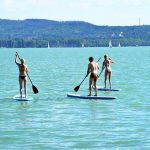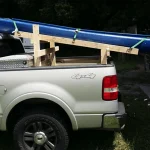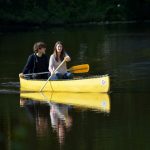When purchasing a kayak paddle, the main focus should be on the paddle angle, shaft material, blade material, paddle weight, paddle length, and paddle features that best suit the type of paddling and type of kayaking you will be doing. adequate research is essential to identify the best paddle for your needs.
Since the days of heavy hand-carved wood, paddle design has progressed significantly. This article provides all the information you need to get a great paddle for kayak fishing, so you can have a great time out on the water!
Which Paddle Length Should I Get?
The most common question among new kayakers is what paddle length is right for them. It can be overwhelming to make the choice, as picking a paddle that is too short can result in banging your knuckles on the side of the boat or having to lean out of the kayak for a clean stroke.
On the other hand, if you choose a paddle that is too long, you’ll be putting extra strain on your shoulders and zig-zagging through the water. Make sure to pick a paddle that pairs well with your kayak.
Simply put, choosing the correct paddle length relies on three things:
- Paddler height
- Width of the kayak
- Paddling style
Paddling Style
Kayak paddles come in two different styles: high-angle and low-angle. High-angle paddles have more surface area and are taller and shorter, while low-angle paddles have less surface area and are thinner and more drawn out.
The style of paddling you use depends on what type of activity or water you’re focusing on. Low angle paddling is good for sea kayaking long distances, open water lakes and rivers, and leisurely touring. It lets you paddle further without getting as tired.
High-angle paddling is better for whitewater kayaking, fast-flowing river kayaking, or paddling where you want to make big fast adjustments.
High Angle
. High Angle Paddling is a stroke in which the paddle blade enters the water from a higher or more vertical angle. More of the blade is in the water, which generates more resistance and more power in a single stroke.
Low Angle
The trade-off is that it requires a lot more strokes to move the same distance as High Angle Paddling This type of paddling uses a more relaxed stroke that is good for long-distance touring.
The paddle blade enters the water at a lower angle, which means less of the paddle is in the water and there is less resistance. The trade-off is that it requires more strokes to move the same distance as high angle paddling.
Choosing a Blade Shape
Blade Shape
The shape of your paddle blade is mainly determined by your paddling style. If you are a high-angle paddler, you will want a paddle with a shorter, wider blade with more surface area to push more water and generate a stronger stroke.
If you are a low-angle paddler, you will want a paddle with a longer, thinner blade with less surface area so you can paddle more efficiently and relax more while doing so.
Material
Kayak paddle blades are made of three materials: fiberglass, carbon fiber, and plastic. The pros and cons of each material should be considered when deciding which paddle to buy, taking into account factors such as durability, stiffness, price, and weight.
Paddle Shaft
The shaft of the paddle contributes the most to the overall weight of the paddle.Materials such as aluminum, fiberglass, and carbon fiber are commonly used because they have a low price in relation to their weight.
Aluminum paddles are usually the cheapest option. They’re strong, but heavier than other materials, and the temperature of the shaft can vary significantly.
If you’re looking for a kayak paddle shaft that is stiff, strong, and light, fiberglass or carbon fiber would be good choices.
A paddle can have a straight or bent shaft. A bent shaft paddle is similar to a curl bar, with ergonomic bends in the handle that put your hands and elbows at a better angle for paddling.
They’re more popular for whitewater kayaking than recreational and fishing kayak outings. I prefer a straight shaft paddle.
Feathering
The shaft of a paddle can be constructed from one, two, or four pieces. A four-piece paddle is purely for portability, while a one-piece paddle will provide maximum energy transfer and strength.
The only downside to a one-piece paddle is that it must be used with matched blades. A two-piece paddle is the most common type and allows you to choose between matched or feathered blade alignments.
This provides the most power possible during the forward stroke. The two blades on your kayak paddle should be aligned with each other, and on the same level, in order to create the most powerful forward stroke.
The blades of the paddle are not positioned directly across from each other so that wind resistance is reduced when the paddle is not in the water.
Ferrule
I had to look up what ferrule means. It’s a piece that connects the parts of a kayak paddle.
Paddle Swing Weight
You will feel the difference at the end of your arms in a very short amount of time. Although it may seem like a small weight difference, it does make a difference when paddling for an hour.
I guarantee that you will feel the difference in your arms after a short amount of time if you paddle with a basic heavy paddle and then switch to a carbon fiber lightweight paddle. Also, look at the math:
The basic paddle weighs 37 ounces while the high-end paddle only weighs 23 ounces. This means that you have to stroke the paddle 14 extra ounces per stroke.
If you’re out fishing, you’re probably paddling around 3 miles. I estimate that it takes 500 strokes to paddle a mile.
for your average golfer The average golfer would need to swing an extra 1312 pounds to cover 3 miles with 500 strokes.
That’s a lot of additional weight! And yes, I promise you will feel it tomorrow.
Best Kayak Paddle for Fishing Reviewed
If you are new to kayaking, you might not know what you need. Even experienced kayakers may not know what to look for in an angling paddle.
If you’re looking for help with choosing an angling paddle, look no further! Below you’ll find reviews of some of the best options out there.
Bending Branches Angler Ace
The Angler Ace by Bending Branches, a well-respected paddle company with decades of experience, really hits the mark for what kayak anglers crave.
Made of carbon fiber and reinforced with carbon-fiber-reinforced nylon, this paddle is incredibly light and very stiff, making it much more efficient than lower-end paddles. You won’t lose any of your strength to flex, which will be especially noticeable on long paddles.
The Angler Ace has a blade shape that is a combination of slim and fat, which gives you control when you need it and makes it more efficient over long distances. There is also a line catcher notch on the left blade, which can be useful when you need to reach something.
The ferrule on this rod can hold either matched or 60-degree offset blades, and the shaft is marked in increments to help you measure your fish.
This paddle is great for open water and long paddles, and while it may not be the best paddle for moving water, it works well on rivers.
I’m not sure if this is the best paddle for kayak anglers, because the competition is fierce.
If you choose the Angler Ace, you will not be disappointed.
Pros:
- Very light
- Extremely stiff
- Excellent hybrid blade shape
- Line catching notch included on the left blade
- Adjustable ferrule allows matched or feathered blades
Bending Branches Angler Classic
The Bending Branches Angler Classic paddle is a good value option that doesn’t sacrifice quality. It’s essentially the same as the more expensive Angler Ace paddle, but made with less expensive materials.
Even though it’s made with cheaper materials, it still manages to have the same weight as the more expensive paddle.
Stroking with the Angler Classic immediately reveals that fiberglass is very strong and remarkably stiff. You’ll find that each pull through the water gives you just a bit more oomph than a paddle less stiff.
If you’re considering the carbon fiber Ace over the Classic, it probably has to do with efficiency. The carbon fiber Ace would be my choice for long paddles.
Although the Classic is available in high-viz orange, which is a very safe color to wear on the water, some people still prefer to wear other colors.
If you’re familiar with the Ace, the Corvus will look very similar. It has the same push-button ferrule that allows you to use either matched blades or 60-degree feathering.
The shaft has the same measuring marks, and the blades have the same shape. The only difference is that the left blade has a line-catching notch.
Go for the Angler Classic instead if you’re on a budget that doesn’t allow for the Ace. You won’t regret it!
Pros:
- Very light
- Very stiff
- Excellent hybrid blade shape
- Line catching notch included on the left blade
- Adjustable ferrule allows matched or feathered blades
Cons:
- Not quite as stiff as the Angler Ace
Werner Cyprus
Werner’s Cyprus paddle is great for river fishing, better than any other paddle I’ve reviewed.
This paddle is built from entirely carbon fiber, which provides instant and total energy transfer with each stroke. The Cyprus blades on this paddle bite into the water, moving more water than longer, skinnier options, which improves control measurably.
The Werner has an adjustable two-piece ferrule system that can be set at 15-degree increments from matched to 75 degrees of right-hand offset. I think this level of customization is great for the price point.
The Cyprus is designed to be functional for anglers where the current is strong.
Pros:
- Extremely light
- Extremely stiff
- Excellent blade shape for moving water
- Adjustable ferrule allows matched or feathered blades with great customizability
Cons:
- Expensive
Werner Camano
The Werner Camano is a good choice if you’re planning on doing a lot of open-water paddling.
The Wernercarbon fiber shaft is unmatched and they have cut costs by combining it with fiberglass blades. You will notice the stiffness right away when you paddle and appreciate it even more the longer your trip.
The Camano has longer, thinner blades than the Cyprus, making it more efficient for paddling but less controllable. It is therefore a good choice for paddling over long distances, but not so good for moving water or strong currents.
It features an adjustable ferrule like the Cyprus, which allows you to change the blades in 15-degree increments from matched to feathered, with up to 75 degrees of right-hand offset.
The text is suggesting that open water swimmers should use a high-visibility swimsuit to make themselves more visible to powerboats.
Pros:
- Very light
- Extremely stiff
- Excellent blade shape for open water and long paddles
- High-vis colors available
- Adjustable ferrule allows matched or feathered blades with great customizability
Backwater Paddles Assassin
Backwater Paddles is known for making short, one-handed paddles that are meant for hard-core anglers who need a tool that can get their ‘yaks, canoes, and pirogues into tougher areas.
The Assassin is the next step in the company’s product line. It is a two-piece kayak paddle that is built to withstand harsh environments.
First of all, do not expect the lightweight version. The Assassin is designed as a tool to clear foliage, catch branches, cut water grass, and generally force your way through tight spots and into hidden honey holes. It is not going to compete with anything Werner has to offer.
This is a paddle for anglers who go into swamps, mangroves, and salt marshes. If you are one of these anglers, you are just as likely to use a paddle as you are to use a push pole. And it works well in that role.
Although the blade is stiff, the paddling efficiency is nothing special. This is due to the unusual blade shape which is designed more for power and control. The Assassin performs well in currents.
The shaft of the spear can be adjusted to two different lengths: 230-240 cm and 250-260 cm. This is done by screwing down the ferrule, which also allows for infinite feathering options.
This system is the heaviest paddle on our list, but it is also the most expensive.
The blades have a big notch to snag lines, branches, rope, and weeds, and a serrated edge on the tip to grip mud or cut weeds.
Although many anglers will not find these additions helpful, if you think they will be useful to you, go ahead and try them out.
Pros:
- Excellent blade shape for push-polling and fighting foliage
- Adjustable ferrule allows matched or feathered blades with extreme customizability
- Adjustable lengths
- Very, very tough
Cons:
- More push-pole than pure paddle, this isn’t the best option for long journeys



